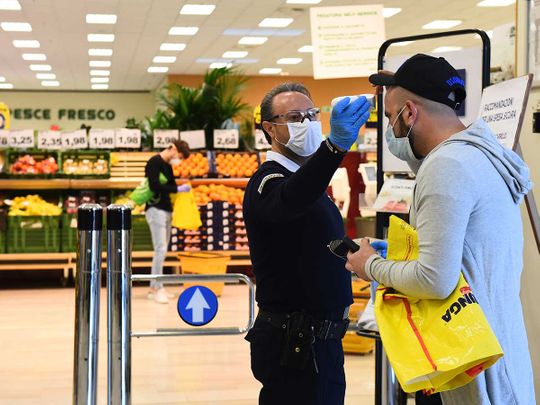
Dubai: When Pope Francis called for a ceasefire in all conflicts and global solidarity in fighting the coronavirus pandemic on Sunday after the Easter mass, it may have sounded like just another message from the Vatican.
The pontiff condemned arms manufacturing, urged the relaxation of international sanctions and said the pandemic should encourage leaders to end long-running wars.
Think of this for a minute. What would a world without wars look like? Would the money saved be enough to kick start a tottering economy? Will this even be possible? Let’s look at the facts.
How much has COVID-19 cost us this far?
The Asian Development Bank says that the cost of the coronavirus pandemic could be as high as $4.1 trillion - or almost 5 per cent of the GDP – depending on the disease’s spread through Europe, the US and other major economies. A shorter containment period could limit the damage to about half the figure, an ADB report said. The problem is that the numbers could increase depending on the spread and delay in containing the disease.
“No one can say how widely the COVID-19 pandemic may spread, and containment may take longer than currently projected,” Yasuyuki Sawada, the ADB’s chief economist, said. “The possibility of severe financial turmoil and financial crises cannot be discounted.”
$ 2.2 trillion
stimulus package offered by US
A month ago, the ADB had said the virus outbreak could cost the world economy $347 billion. Since then, the epicentre of the virus has shifted from China to Europe and the US, with the number of global infections now nearly 2 million.
Gita Gopinath, the IMF's chief economist, told a news conference via a video link on Tuesday that under the Fund's best-case scenario, the world is likely to lose a cumulative $9 trillion in output over two years - greater than the combined gross domestic product of Germany and Japan.
How much do wars cost?
Although it is difficult to round off a figure that is being spent every year to fight wars, some estimates do give us an idea.
The cost of the Gulf War was approximately $76 billion. Vietnam cost $500 billion; the Korean War, $336 billion; and World War II, almost $3 trillion, according to Chris Hedges, in his book What Every Person Should Know About War.
The US wars in Afghanistan, Iraq, Syria and Pakistan have cost American taxpayers $6.4 trillion since they began in 2001, according to a report from the Watson Institute of International and Public Affairs at Brown University. It also found that more than 800,000 people have died as a direct result of the fighting.
Frank Ledwidge, author of the book Investment in Blood, says the war in Afghanistan has cost UK around 40 billion pounds, enough to recruit over 5,000 police officers or nurses and pay for them throughout their careers. It could fund free tuition for all students in British higher education for 10 years.
Multiply these figures by the dozens of wars being fought around the globe every year and we will arrive at a colossal figure.
Has the world ever been at peace and how many people have died in war?
Of the past 3,400 years, humans have been entirely at peace for 268 of them, or just 8 per cent of recorded history, according to the book What Every Person Should Know About War. Estimates for the total number of people killed in wars throughout all of human history range from 150 million to 1 billion, the book says. Besides, war has several other effects on population, including decreasing the birthrate by taking men away from their wives. The reduced birthrate during World War II is estimated to have caused a population deficit of more than 20 million people.
The Uppsala Conflict Data Programme (UCDP), the provider of statistics on political violence, has identified 285 distinct armed conflicts since 1946. This includes all organised military conflict over government or territory involving one or more state government(s) and causing at least 25 battle-related fatalities in a year
The number of armed conflicts in the world in 2017 was 49, according to the Uppsala Conflict Data Programme (UCDP). Nearly 69,000 people were killed as a direct consequence of state-based armed conflicts in 2017.
Is there a genetic reason why we fight and why are civilians attracted to war?
There is no single "war gene." Combinations of genes can predispose a person to violence. However, aggression is a product of biology and environment, Chris Hedges says. War is often regarded by observers as honourable and noble. “It can be viewed as a contest between nations, a chance to compete and be declared the victor.”
How much are governments spending as stimulus to help COVID-19-ravaged nations?
Led by the United States, the world’s largest economies -- China, Japan, Germany, France and the United Kingdom -- have committed vast sums to prevent economic meltdowns.
By far the most extensive stimulus package is the US $2.2 trillion Coronavirus Aid, Relief, and Economic Security (CARES) Act. It promises a one-time cheque of up to $1,200 for Americans who earn less than $75,000 per year. CARES amounts to more than 10 per cent of Gross Domestic Product (GDP).
Japan has followed with a $996 billion stimulus package, amounting to 20 per cent of GDP. The 19-member eurozone follows with a $590bn bailout.
Considering the amount of money spent on war, the bailout packages needed to lift the economy, and based on the destruction and loss of life that war brings, leaders must work together to ensure peace in a post-COVID-19 world.
The earth can ill afford a war after spending all its resources fighting an invisible enemy.








